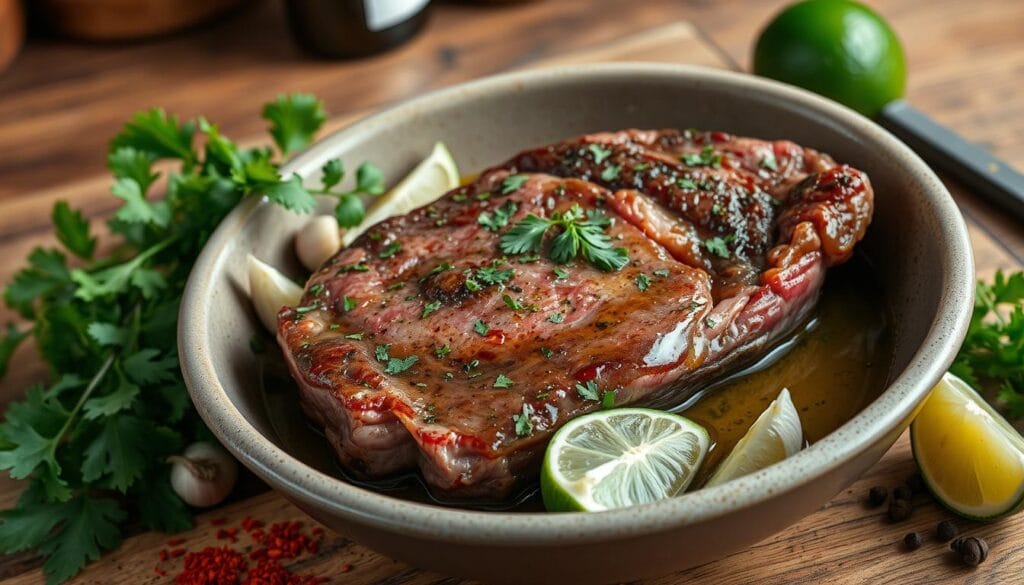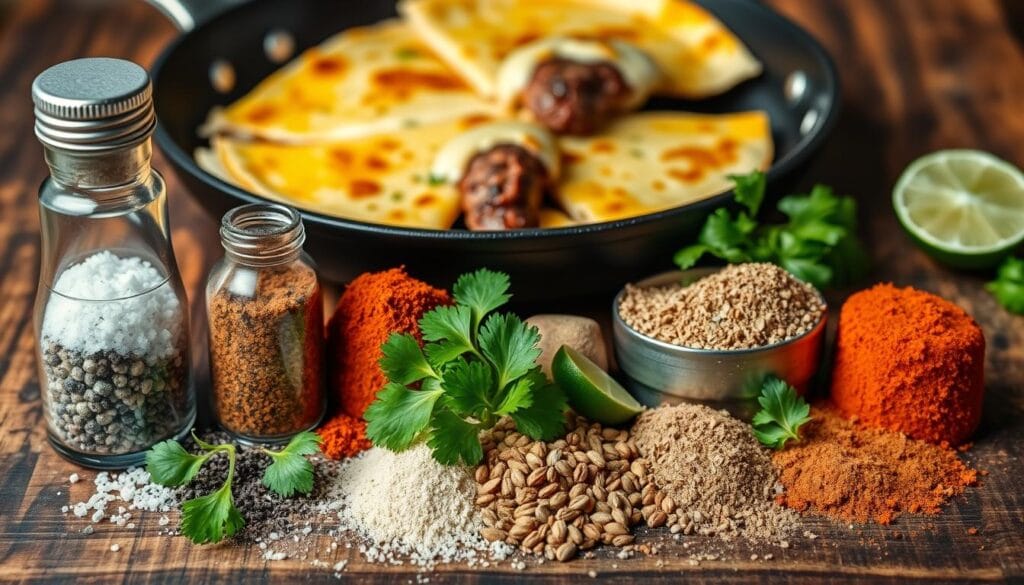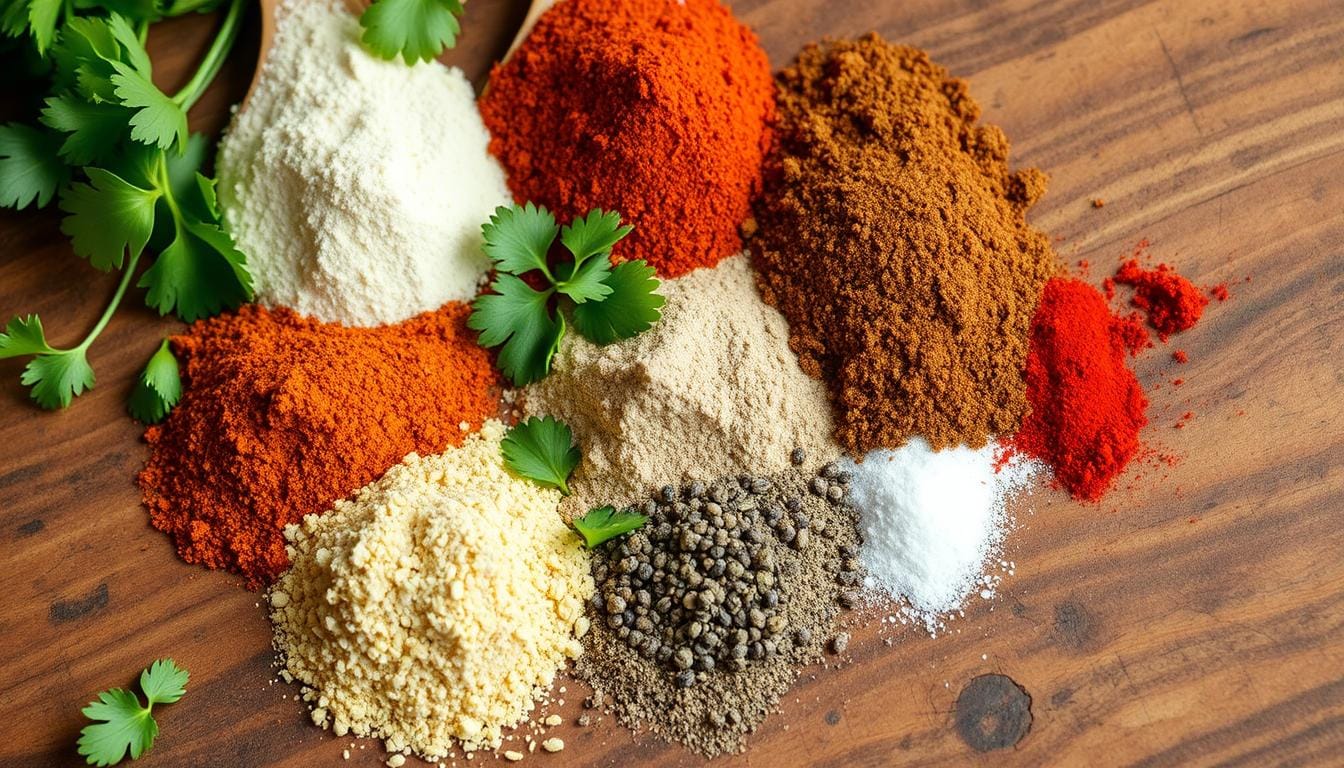Best Seasoning for Steak Quesadillas: Perfect Flavor
Ever had a quesadilla that left you wanting more? I’ve been there too. But don’t worry, I’ve found the secret to amazing steak quesadillas.
The secret is in the seasoning. A mix of garlic powder, cumin, paprika, and a bit of cayenne makes all the difference. Add a tender steak, melted cheese, and a crisp tortilla, and you’re in for a treat.
Table of Contents
Understanding the Perfect Steak Quesadilla Components
Making the ultimate steak quesadilla needs careful thought for each part. Choosing the right steak and controlling the temperature are key. Let’s explore the important details to make your steak quesadilla amazing.
Choosing the Right Cut of Steak
For steak quesadillas, pick tender, flavorful cuts that are easy to slice. Flank steak, skirt steak, ribeye, or sirloin are great choices. They offer the perfect texture and taste. Make sure the steak can be sliced thinly against the grain for a tender bite.
Essential Kitchen Tools and Equipment
You’ll need some key tools to make the perfect steak quesadilla. A sharp knife is essential for precise steak slices. Also, a cast iron skillet or grill pan is best for cooking. They ensure even heat and a crispy exterior.
The Role of Proper Temperature Control
Controlling the temperature is crucial for a perfectly cooked steak. Cook the steak to 140°F for medium doneness. This makes it tender and juicy. Let the steak rest before slicing to keep it tender and prevent juices from being lost.
“The secret to a truly outstanding steak quesadilla lies in the perfect balance of tender, flavorful steak and the right cooking techniques.”
Understanding these key components will help you make delicious steak quesadillas. Your family and friends will love them. Stay tuned for more tips on seasoning and cooking to take your quesadillas to the next level.
Essential Seasoning for Steak Quesadillas
Make your steak quesadillas taste like they’re from Mexico with a special seasoning mix. You’ll need sea salt, garlic powder, ground cumin, paprika, and a bit of cayenne pepper for a hint of heat. You can adjust the spice to your liking.
Marinating the steak for 30 minutes to 2 hours before cooking is key. This lets the flavors soak into the meat, making it taste richer and more flavorful. Adding a few tablespoons of adobo sauce to the marinade can give it a smoky, tangy flavor.
| Ingredient | Quantity |
|---|---|
| Flank Steak or Skirt Steak | 16 ounces |
| Salt | 1/2 teaspoon |
| Garlic Powder | 1/2 teaspoon |
| Chili Powder | 1 teaspoon |
| Cumin | 1/2 teaspoon |
| Dried Oregano | 1/2 teaspoon |
| Adobo Sauce (optional) | 2 tablespoons |
Using these essential seasonings will bring the true flavors of Mexico to your steak quesadillas. You’ll end up with a dish that’s so good, you’ll want more.
Traditional Mexican Spice Blend Basics
Making the perfect steak quesadilla begins with authentic Mexican flavors. At its core is the Mexican seasoning blend. This blend is a mix of spices and herbs that brings Mexico’s essence to every bite.
Core Mexican Spices and Herbs
The key to a great Mexican seasoning blend includes:
- Cumin – It’s earthy and warm, giving Mexican dishes their savory taste.
- Chili Powder – Made from dried chili peppers, it adds depth and heat.
- Oregano – This dried herb adds a subtle, herbaceous flavor.
- Cilantro – Fresh cilantro brings a bright, citrusy taste to the mix.
Balancing Heat and Flavor
The mexican seasoning blend is known for its heat. But, the real skill is balancing spice and flavor. Adding milder spices like paprika can help, letting other flavors stand out.
Traditional vs Modern Seasoning Approaches
Traditional Mexican seasoning uses dried chilies and strong herbs for a real taste. But, modern recipes might add new twists. Feel free to try different tex-mex seasoning mixes to make your steak quesadillas even better.
“The secret to the perfect steak quesadilla lies in the balance of spices and the harmony of flavors. Embrace the essence of Mexico and let your taste buds embark on a flavorful journey.”
The Art of Marinating Your Steak
Marinating your steak is key to making the perfect steak quesadilla. It’s a simple way to bring out the best in your steak. By using a mix of steak seasoning, fajita seasoning, and other ingredients, you can make your steak taste amazing.
To marinate well, find the right mix. Start with olive oil, steak seasoning, and a bit of adobo sauce. Let the steak soak for 30 minutes to 2 hours, flipping it now and then. This makes the meat tender and full of flavor.
For a fast marinade, mix lime juice, garlic, and fajita seasoning. Let it marinate for at least 30 minutes. But don’t marinate too long, or the steak will get too soft.
“The secret to a truly exceptional steak quesadilla lies in the art of marinating. By infusing your steak with the right blend of spices and flavors, you can elevate the entire dish to new heights.”
The quality of your steak matters too. Choose a well-marbled flank or skirt steak. These cuts soak up flavors well and stay juicy. With the right marinade and patience, you’ll make a fantastic steak quesadilla.

Premium Cheese Selection for Quesadillas
Choosing the right cheese is key to a great steak quesadilla. The cheese adds flavor and makes the quesadilla melt perfectly. Opt for premium Mexican cheese for the best results.
Mexican Cheese Varieties
Popular choices include queso asadero, queso Oaxaca, Monterey Jack, and Mexican cheese blends. These cheeses melt well and pair well with seasoned steak.
Melting Properties and Combinations
Grate the cheese yourself for better melting. This way, it melts evenly in your quesadilla. Try mixing cheeses like Monterey Jack and cheddar, or queso Oaxaca and queso fresco.
The secret to a tasty steak quesadilla is using the right cheese. With the right cheese, your quesadilla seasoning will shine, making your dish even better.
Preparing the Perfect Tortilla Base
Starting with the right tortilla is key to making great steak quesadillas. Choose large, burrito-sized flour tortillas for the best results. Before you fill them, lightly heat the tortillas in a dry skillet. This makes them flexible and prevents them from tearing.
To get a crispy exterior, brush the tortillas with a bit of oil before cooking. This step adds a nice crunch that complements the steak and cheese inside.
For those who prefer gluten-free options, corn tortillas are a great choice. They have a unique flavor and a sturdy texture that works well in steak quesadillas. Try different types to see which one you like best.
“The key to a perfect quesadilla is all in the tortilla. A lightly toasted, pliable base is the foundation for the ultimate steak seasoning and melted cheese experience.”
The tortilla is the base of your steak quesadillas. Make sure it’s prepared well to ensure a delicious meal.
Complementary Vegetables and Toppings
Creating the perfect steak quesadilla means choosing the right vegetables and toppings. Bell peppers, onions, jalapeños, and lettuce add freshness and flavor. These ingredients can make your dish stand out.
Fresh Produce Options
Begin by cooking diced bell peppers and onions in a skillet. Their sweetness and depth of flavor pair well with steak and cheese. Add sliced jalapeños for a spicy kick.
Top it off with fresh lettuce, tomatoes, and cilantro. These add a crunchy, bright touch that balances the dish’s flavors.
Preparing and Seasoning Vegetables
Season your vegetables with salt, garlic powder, and steak seasoning for extra flavor. This blend brings out the natural sweetness and aroma of the produce. Feel free to try other spices like cumin or smoked paprika for a unique quesadilla seasoning.
Adding grilled vegetables or corn or black beans can also enhance your quesadilla. The smoky flavors of grilled veggies complement the cheese and steak perfectly.
“The key to a truly exceptional steak quesadilla lies in the perfect balance of flavors and textures. By incorporating a variety of fresh, seasonally-inspired produce, you can create a dish that is both satisfying and bursting with vibrant goodness.”
Cooking Techniques for Optimal Flavor
To make the perfect steak quesadilla, start by searing your steak. Use a hot cast iron skillet or grill pan for 3-4 minutes on each side. This will give you a caramelized outside and a juicy inside.
After cooking, let the steak rest for a few minutes. Then, slice it against the grain. This makes the steak tender and full of flavor.
When making your quesadillas, put cheese on both sides of the filling. This ensures the cheese melts evenly and gets gooey. Cook the quesadillas in a skillet with butter for 2-3 minutes on each side. They should turn golden brown and crispy.
| Prep Time | Cook Time | Serves |
|---|---|---|
| 5 mins | 10 mins | 4 |
By using these techniques, you’ll make your steak quesadillas even better. The secret is to control the temperature, layer your ingredients right, and get that golden-brown outside. This adds texture and crunch.

Don’t forget about the seasoning for your steak. A good fajita seasoning or your favorite steak seasoning can make a big difference. Try different spice mixes to find the flavor you love.
Signature Sauces and Condiments
Choosing the right toppings and sauces can make a big difference in a steak quesadilla. The mexican seasoning blend and tex-mex seasoning are key for the steak. But the right condiments can take your quesadilla to the next level.
Try the Chipotle Lime Mayo for a great flavor. It’s creamy, tangy, and a bit spicy. Mix mayonnaise, sour cream, chopped pickled jalapeños, lime juice, and chipotle paste for a bold sauce.
- Mayonnaise
- Sour cream
- Pickled jalapeños, finely chopped
- Lime juice
- Chipotle paste
But there’s more. Serve your quesadillas with traditional Mexican sauces and toppings. Here are some:
- Salsa: Choose from tomato-based, pico de gallo, or guacamole. These add freshness and heat.
- Sour cream: It’s cool and tangy, perfect with the spiced steak and cheese.
- Hot sauce: Offer mild to fiery hot sauces for guests to add their own kick.
Adding these signature sauces and condiments will make your steak quesadillas even better. They’ll create a memorable dining experience.
Plating and Presentation Tips
Make your steak quesadillas stand out with great plating and presentation. Start by cutting the quesadillas diagonally. This creates triangles that show off the melted cheese and seasoned steak. Place the slices on a plate, making sure they’re evenly spaced and neat.
Add vibrant toppings to enhance the flavors. Fresh cilantro sprigs add a fresh taste. Diced onions or tomatoes add color. And don’t forget lime wedges for a burst of citrus.
Serving Temperature Management
It’s important to serve your steak quesadillas at the right temperature. They should be hot right after cooking. This keeps the outside crispy and the inside juicy.
For a family-style presentation, put the quesadilla slices on a big platter. Add various toppings and sauces. This lets everyone make their own special dish.
“The secret to a truly outstanding steak quesadilla is in the attention to detail during the final plating and presentation. It’s the last step that brings the entire dish together and leaves a lasting impression on your guests.”
By following these tips, you’ll make your steak quesadillas even better. Impress your loved ones with a dish that looks as good as it tastes. It will show off the perfect seasoning for steak quesadillas.
Storage and Reheating Guidelines
Keeping your homemade steak quesadillas tasty is simple. Store leftover quesadilla seasoning in an airtight container in the fridge for 3-4 days. To reheat, place the quesadillas in a skillet with a bit of butter. Cook on both sides until they’re warm.
For longer storage, freeze your steak quesadillas for up to 3 months. Wrap them tightly in plastic or foil to avoid freezer burn. Thaw in the fridge before reheating in the oven at 350°F for 10 minutes or in an air fryer for 3-5 minutes.
Always check the internal temperature reaches 165°F when reheating. This ensures your quesadilla seasoning stays safe and delicious. Follow these tips to enjoy your steak quesadillas even after the first time you make them.
FAQ
What is the best seasoning for steak quesadillas?
A classic seasoning for steak quesadillas includes sea salt, garlic powder, and cumin. Add paprika and cayenne pepper for extra flavor. You can adjust the spice to your liking.
What are the essential components of a perfect steak quesadilla?
Steak quesadillas have lightly spiced steak and melted cheese in a crispy tortilla. Use flank steak, skirt steak, or ribeye. You’ll need a sharp knife, cast iron skillet, and meat thermometer.
How do I properly season and cook the steak for quesadillas?
Marinate the steak in olive oil, spices, and adobo sauce for 30 minutes to 2 hours. Cook it in a hot skillet or grill pan for 3-4 minutes each side. Let it rest before slicing.
What are the best cheese options for quesadillas?
Queso asadero, queso Oaxaca, Monterey Jack, or Mexican cheese blend are great. Grate the cheese yourself for better melting. Try different cheese combinations for unique flavors.
How do I prepare the tortillas for the perfect quesadilla?
Use large flour tortillas and heat them in a skillet before filling. This makes them flexible and prevents tears. Brush with oil for a crispy exterior.
What are some tasty vegetable and topping options for steak quesadillas?
Add bell peppers, onions, and jalapeños for flavor. Sauté them with salt and garlic. Top with lettuce, tomatoes, and cilantro for freshness.
How can I ensure the quesadillas are cooked to perfection?
Place cheese on both sides of the filling for melting. Cook in a skillet with butter for 2-3 minutes each side. Let the steak rest for tenderness.
What are some tasty sauces and condiments to serve with steak quesadillas?
Make a Chipotle Lime Mayo with mayonnaise, sour cream, and lime juice. Serve with salsa, guacamole, or sour cream. Offer hot sauce and pickled jalapeños on the side.
How should I store and reheat leftover steak quesadillas?
Store leftovers in an airtight container in the fridge for 3-4 days. Reheat in a skillet or oven for crispiness. You can also freeze them for up to 3 months.
Source Links
- Cheesy Steak Quesadilla Recipe – https://myeverydaytable.com/steak-quesadillas/
- Easy Steak Quesadilla – https://overthefirecooking.com/cheesy-steak-quesadilla/
- Steak Quesadillas – https://cookthestory.com/steak-quesadillas/
- Best Steak Quesadillas – https://platein28.com/steak-quesadillas/
- Steak Quesadilla Recipe – https://tornadoughalli.com/steak-quesadilla-recipe/
- Steak Quesadillas – https://thetoastykitchen.com/steak-quesadillas/
- The Ultimate Carne Asada Recipe – https://pinchandswirl.com/carne-asada-recipe/
- The Best Homemade Mexican Spice Blend – https://www.filledwithflavour.com/blog/the-best-homemade-mexican-spice-blend
- Easy Beef Quesadillas/Tacos – https://www.dimitrasdishes.com/easy-beef-quesadillas-tacos/
- A Sizzling Delight: Crafting the Steak Quesadilla Recipe at Home – https://onestophalal.com/blogs/info/a-sizzling-delight-crafting-the-steak-quesadilla-recipe-at-home
- Perfect Flank Steak Recipe – The Big Man’s World ® – https://thebigmansworld.com/flank-steak-recipe/
- Quick-Marinated Picanha Steak – https://wendypolisi.com/picanha-steak/
- Quesadilla Recipe – Love and Lemons – https://www.loveandlemons.com/quesadilla/
- Quesadilla Variety Pack – https://riseandpuff.com/products/quesadilla-variety-pack?srsltid=AfmBOorbJSRXKK38AACsfqpLXDplnEAfsogtuXeoIdkEbfz4Dy2u7RD7
- Best Steak Quesadilla Recipe – 7 Easy Steps for Perfect Flavor – https://themaestrorecipes.com/steak-quesadilla-recipe/
- Steak Quesadillas (Quick + Authentic Mexican Food Dinner) – https://www.theanthonykitchen.com/steak-quesadillas/
- Best Steak Quesadillas Recipe – To Simply Inspire – https://www.tosimplyinspire.com/steak-quesadillas.html
- Cheesy Steak Quesadillas – https://insanelygoodrecipes.com/steak-quesadillas/
- 3 Side Dishes That Pair Perfectly With Quesadillas – https://riseandpuff.com/blogs/rise-puff-blog/3-side-dishes-that-pair-perfectly-with-quesadillas?srsltid=AfmBOorfMC-unthSGc54MTWg2eK7jva8Ei9lHUaMnyAX-aF5PMtvWL5c
- These Blackstone Steak Quesadillas Are So Good They Will Be Gone Before They Make It To Your Plate – Drizzle Me Skinny! – https://drizzlemeskinny.com/blackstone-steak-quesadil/
- The Best Steak Quesadilla Recipe – https://www.grillseeker.com/best-steak-quesadilla-recipe/
- Steak Quesadillas – Crafty Cookbook – https://www.craftycookbook.com/steak-quesadillas/
- Steak Quesadilla – https://britneybreaksbread.com/steak-quesadilla/
- Easy Steak Quesadilla Recipe Ready in 20 Minutes – https://instantrecipeshub.com/steak-quesadilla-recipe/
- Steak Quesadilla – https://whitneybond.com/steak-quesadilla/
- Blooming Quesadilla Ring Recipe by Tasty – https://tasty.co/recipe/blooming-quesadilla-ring
- Beef Quesadillas Recipe | Simple Home Edit – https://simplehomeedit.com/recipe/beef-quesadillas/
- Understanding the Shelf Life of Beef Quesadillas: Storage Tips – https://discover.texasrealfood.com/food-shelf-life/how-long-do-beef-quesadillas-last
- Fully Loaded Steak Quesadilla! – https://foodieandwine.com/quesadilla-with-steak/

